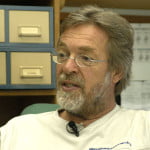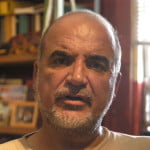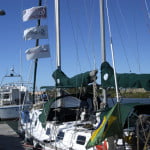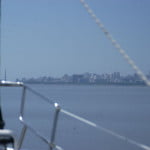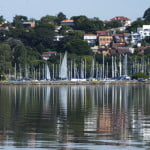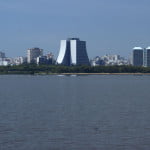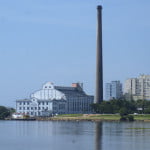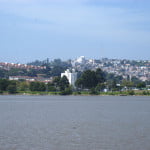Tuesday, 27- 03- 2007.
This is the last trip. I thought that nothing else would surprise me after having sailed for so long and passed tiny little villages, dozens of cities and several capitals. I packed my luggage thinking about this. However, as soon as I arrived in Porto Alegre, after having visited the old center and the neighborhood, I realized I was completely wrong.
Today, we explored the city and the crew of the Endless Sea was speechless.
Porto Alegre is a new city. It was found 234 years ago. This is the reason why you don’t see Rio Grande do Sul’s capital as part of the national Historic Patrimony. We were really surprised when we saw some of the old buildings. Most of them were built at the end of the 19th century and the beginning of the 20th; however this doesn’t make them less impressive. They are monumental like the huge cathedral, Mario Quintana Cultural Center, Nossa Senhora das Dores Church, the old Gasometro station from 1928 or the Market Square with the building where the city hall was.
I’ve always thought that Porto Alegre was on the banks of the Guaiba River until we had our first interview with professor Luiz Fernando Cybis from the Hydraulic Research Institute from Rio Grande do Sul’s Federal University. It was hard to believe when Professor Cybis told us: “the name has not been definitely chosen, it is being discussed: Guaiba Lake or the Guaiba River? For the meantime, it is Guaiba Lake. But that’s not all. A little bit later we saw the Jacui Delta. I was wrong again. But let’s talk about that another day.
Since I’m writing the last logbook, I want to be optimistic. We must and there are enough reasons to believe that there is hope. That’s why, during this trip, every day I will put emphasis on a positive action I found. They are successful isolated solutions for recurring problems.
I will start by the example of Paraiba’s State Constitution which prohibited skyscrapers in the front streets of the shore, fighting against and “domesticating” real state speculators, and setting rules for the building industry. It is the only coastal state out of seventeen which preserved the integrity and the natural beauty of the landscape. Environmentalists told us that every new administration puts heavy pressure on the Executive for changes. However, at the slightest sign of weakness “people go to the streets”. This is the model which has been adopted so far. There is time left to follow this model.
Wenesday, 28 – 03 – 2007.
We went to the university to talk to Professor Cybes who spoke about Guaiba’s eccentricities. It is formed by the Jacui (the biggest) as well as by the Sinus River, the Cai River and the Gravatai River. From the beginning to the end where it meets Patos Lagoon, it is only 25 miles long. It is submitted to “the seiche effect”, according to the Professor, “just a few water bodies in the planet have it”. He explained: “When the south wind blows, the waters of Patos lagoon go up and since they are at a level higher than those of the river, they push the waters up. Since the course is changed, bays are formed on the banks, something that occurs typically with lagoons, not rivers”. He added: An act was passed in which it was written Guaiba Lake and then we decided to use the same language (he was talking about the academic community, the government and the NGOs).” I asked about the situation of the lake, since he was saying that at the end of the eighties it was so bad that a movement was born to save it, like the Tietê River and the Guanabara Bay’s: Pro-Guaiba.
One more time the problem was pollution, especially in the urban area, but not only. The estimated population in the neighboring area of the bay of the Guaiba River is 1.445.889 thousand inhabitants. Only 1.2% come from rural population. Just Porto Alegre has 955 tons of solid waste (garbage) per day. Viamao produces 123 tons and Canoas 100 tons/day, just to mention the most important ones. It is estimated that about two thousand companies are established along the bay. 350 have a polluting potential and 15 were mentioned by the Guaiba Lake Committee, an agency of the state government, as being responsible for 23% of all the pollutants thrown in it. Even if it is a minority, agriculture is the main economical activity in many districts of the neighboring areas; like tobacco in many of them, cellulose reforestation in others, and finally, rice culture in the districts on the right bank. Obviously, they use herbicides … Additionally, there is the hydroway, built between 1928 and 1930, which made it navigable from Jacui, the Guaiba “lake” to Patos Lagoon.
These impact activities brought dramatic consequences in an area which concentrates two thirds of the state population, 30% of the area and 70% of the gross domestic product. The “population demand made state authorities decide”, said the Environment Secretary, Vera Callegari. The Pro-Guaiba Movement (officially founded in 1995) and the Committee of Lake Guaiba Hydrographic Bay resulted from that (State Act 38.989, October 1998). Vera says that the lack of basic sanitation was the main factor that led to Pro-Guaiba. Like Tiete’s campaign in Sao Paulo, the situation is better. The government made an agreement with IADB (Interamerican Development Bank) and 220 million dollars were invested – 60% from the institution and 40% from the government. 120 million dollars were spent to build two new water treatment stations; the first part of an ambitious decontamination program of four phases and it will take a couple of years. Before the investment, only 5% of the waste of the districts were treated. Today, the percentage is 9%; 25% of Porto Alegre’s homes benefit from it.
Vera says that the second phase, “after putting all the projects together”, will require more than 575 million dollars, 80% for basic sanitation. The new government is worried because the state is broke; this is the reason why right now “we can’t bring this money from abroad (the state’s share isn’t available for the agreement)”. I’m sure they will find a way to make these funds available, they are determined. Here we have one more example, this time it shows how important public opinion is. It was responsible to recover the Tiete and the Guaiba Rivers; this means that if they were able to, others will be able as well. There is technology for that. Political will is the only thing that is necessary. Both situations prove that when Sao Paulo and Porto Alegre’s population acted like citizens and expressed its opinion, the answer was accordingly. The example is clear: learn to be stubborn. Always protest! Demand, found an NGO for the sake of your state’s river, if necessary, but don’t accept passively. Just complain and expect OTHER PEOPLE’s changes doesn’t help. You cannot loose your ability of showing your indignation. In addition to acting you must believe.
Thursday, 29 – 03 – 2007.
Yesterday was full of good surprises. After the interview with the Environment Secretary, we visited the Jacui Delta, we accepted the secretary’s suggestion and means. Pro-Guaiba’s Executive-Director, Ana Elizabeth Carrara, followed us. The Delta is only 5 minutes far from the city center (by motor boat). It is formed by countless islands which emerged right after the mouth of the Jacui River such as Maua Island, Pintada, Polvora, Pavao and Marinheiros Big Island. This area is of utmost importance for the quality of Guaiba’s water, since it acts like a filter and little by little it helps to clean it by renewing and retaining part of the impurities. Additionally, since there is very little occupation, the Delta is the habitat of several birds, fishes and animals such as the otter and the papo-amarelo alligator. The vegetation comprehends swamps, fields and ciliary forest. It was fantastic to cross these rivers and canals of great beauty and to see Porto Alegre’s buildings from afar.
Ana told us that one of the things done was to turn that area into an APA (Environmental Protection Area) so that state authorities coordinate and direct occupation. I never thought that a coastal metropolitan area could be close to such a rich space in terms of biodiversity. Rio Grande do Sul was hiding one more good surprise for the end. We spent the afternoon visiting it. I’d like to mention a few additional good examples. Our oceanic islands can be “lighthouses” as well. Sao Pedro and Sao Paulo, Atol das Rocas, Fernando de Noronha, Abrolhos, Trindade and Martim Vaz still have a significant part of their richness due either to the preservation of the landscape or that of maritime life or birds. Two of them are big enough or near enough the continent to welcome tourists: Abrolhos and Fernando de Noronha. I’ve known them since the beginning of the 80’s. They both have Maritime National Parks and are protected by Ibama. Both succeeded in preserving their main characteristics in spite of tourists, goats and fishing as far as Abrolhos is concerned; in spite of grasshoppers, human occupation and secular deforestation in Fernando de Noronha. Why isn’t this example disseminated?
Friday, 30 – 03 – 2007.
Yesterday early in the morning, we left Veleiros do Sul Yacht Club where one more time we were welcome with open arms. We were constantly congratulated by members and people who work there especially for our “impartiality and courage” when we denounce absurd facts present on our coast. We sailed 25 miles towards Itapua End where the lighthouse with the same name is the landmark of the beginning of the Guaiba for those who sail through Patos Lagoon. We wanted to visit Itapua State Park, Pro-Guaiba’s one more youngster with 5.566 hectares. This is an emblematic Conservation Unit in Rio Grande do Sul. This Unit’s history is full of trouble.
Founded in 1973 as a Tourist Park, it was protected only officially like many others we have already visited. Predators didn’t care about legal fiction. There is plenty of pink granite in the area. Huge rocks, formed in 500, 600 years, were the first victims but not the only ones. After they were dynamited, part of it was turned into posts and paving stones which drove environmentalists mad. However, one of them, a remarkable one, stopped their action. Professor Lutsenberguer’s furious alert cry against vandals was the drop in the bucket which made them stop. That’s how the park was founded. Nevertheless, as I said, at the beginning it was just legal fiction.
The situation changed when Pro-Guaiba got funds for it. And then Gauchos decided to create a Conservation Unit model. They spent money on it and the result was excellent.
The park was closed between 1981 and 1991; enough time to revitalize part of the flora and fauna; in the meantime infrastructure was established. After it was reopened, visitors find it marvelous. There are 80 people working in the park: administrators, caretakers, park guards as well as other people who take care of it. There is also a limit number of visitors. The management plan allows 900 visitors per day during the high season; however, there are restricted areas where only 300 people are allowed. There are more sensitive areas where only 15, 20 visitors are allowed. The critical ones are completely forbidden.
The main ecosystems are beaches, granite hills, dunes, islands, lakes, reefs, swamps and fields. Fauna comprehends migratory and local birds, reptiles such as papo amarelo alligators, and mammals such as red-head monkeys, leopard cats, otters and maracaja cats – all of them on the edge of extinction – and capybaras.
We visited the Park guided by the head of Rio Grande do Sul’s Conservation Units’ division, Luiz Alberto Mendonça who made us visit every inch. It is marvelous. A microcosm of Rio Grande do Sul’s ecosystems which is only 57 kilometers far from the capital. Everything is perfect. From accommodation to the projection room as well as public toilettes, barbecue grills, entrance gates, etc.
Compared with other Parks or Conservation Units, it has the best infrastructure. This park and the Cardoso Island State Park have the best results. They are remarkably positive. They have shown it is possible both to occupy and preserve.
This morning we started our last sailing, from this point to Rio Grande through Patos Lagoon (this is one more thing we have learned: although the name is Lake, its fresh water receives salt water, this is the reason why the right name is lagoon) about 140 miles.
We left at dawn. I was worried. Sailing in Patos Lagoon can be risky. The area of 10 thousand square kilometers is low, the average depth is 7 meters. When the southwest wind blows is tumultuous. High and short waves are formed. These things are feared when you are in a boat. However, the weather was good and we took our destination. At the beginning we passed several ships. Three in a row at Itapua Lighthouse. And then it was calm until it got dark. I would like to mention a fishing boat which dared to throw the net in the middle of the lagoon, breaking the law and contributing to bring its activity faster to an end, that is fishing. At the end of the afternoon, I was sleeping when I felt familiar crashes at the bottom. I suddenly woke up and rushed out. Alonso was at the rudder trying to avoid the sprinkling while Paulina was crouched trying to hold the dog-house (front awning) so that it didn’t go up and blocked his view. The south wind was blowing furiously; whistling, beating and agitating the sea. The crashes scared me, so I went to the sitting room and Cardozo told me “it is better now” , a few minutes earlier it had reached 40 knots. Jesus Christ! When are we going to sail peacefully?
It was a dark night, we could barely see the demarcating buoys on the canal. We were 12 miles away from Saragonha island and if we wanted to reach it, we had to sail in lower areas, at a depth bellow 2 meters. I didn’t hesitate, I asked to drop the anchor.
But then Alonso asked if I was sure and I answered of course. Right here, in the middle of the canal where those who cross it pay attention to avoid getting lost. This is better than facing sand banks with waves and strong winds. The motor was on all night long and we were permanently watchful.
That’s what we did, that is, Alonso did… It is ten to 1 a.m. I can hear my friend yawn in the cockpit; he is watching the horizon. Cardozo is sleeping in the room where I am writing and Paulina, it’s been a long time since she went to the cabin. That’s where I’m going to right now.
Saturday, 31 – 03 – 2007.
We woke up very early in the morning with nets and boats around and a few meters away from Saragonha Island. Yesterday, when I plotted our position on the nautical map, the distance seemed to be longer, I don’t know why. Anyway, to stop at that moment was the best decision. Even a small boat which was behind us took the same decision. I took pictures and Cardozo shot hundreds of caicos when they were fishing shrimps.
And then we sailed among nets and sticks on both sides at a very low depth until Rio Grande. Alonso got mixed up only once, it was possible to hear the keel making the toc, toc, toc noise at the bottom.
It was midday when we arrived at Rio Grande Yacht Club.
Now I want to mention a character who plays an important role on the coast: Non-Governmental Organizations.
You can see them in Belem, in the state of Para. They are absent in Maranhao and Piaui, and are present again in Ceara and all the other states. Their activity is very important. They study ecosystems, put pressure on public administrations, mobilize populations, qualify indigenous people for different activities and promote conservation.
Some of them are very big; they have partners and/or domestic and foreign funds; others don’t have that much. However, all of them are successful.
The organization which most impressed me is unknown. A few abnegates who have neither partners nor financial support, not even a web site. Nevertheless, they are co-responsible for the integrity of Babitonga Bay, on the north coast of Santa Catarina.
There is also Ameca with Ana Paula Cortez which I have already mentioned. Willingness, public cause spirit and competence made this NGO submit Petrobras to its rules, sued the city’s administration (for neglecting basic sanitation) and was able to demolish irregular buildings which is a very, very difficult task. This organization’s aim is to hit the Achilles’ heel of those who even inadvertently damage and modify the landscape and ecosystems by breaking the rules. They are good at hitting the target.
It is a definite proof that after all the only thing required to be successful is willingness to fight.
Sunday, 01 – 04 – 2007.
Sunday was devoted to a show: a regatta of typical boats, caicos with trapezoidal sails which are part of the festivities of Rio Grande’s traditional Festa do Mar.
We watched it in the organization boat. There was strong south wind and approximately 15, 20 participant boats. A beautiful show. A simple apotheosis of colors, shapes, textures and old know-how. At the end, the air squadron made a performance. The contrast between the modern show in the air and the tradition in the sea was evident. A coincidence was remarkable: the perfect equivalence of both. A large number of people watched it and was exultant on the platform of the port.
Now I will talk about additional successful actions on the coast. They are Tamar, Peixe-Boi, Jubarte Whale, Rotator Dolphin and Albatross Projects. The common thing is the fact of having started as isolated actions and today they are under Ibama’s protection. They protect turtles, mammals, cetaceans and birds and are undeniably successful. People from these projects as well as those like Carla Marcon from Paraiba and other people in charge of protection areas which have already been mentioned in previous logbooks, they are what we call Ibama’s “good people”. They have plenty of merits.
There is also another group of professionals who impressed me: professors and researchers from the academic community who we talked to. We interviewed over 40 of them in these seventeen coastal states. Their knowledge, devotion and competence are remarkable.
The federal and state governments should talk about their action more often, but this is the negative aspect. If they did so, I’m sure our coast would be in a better situation. It seems the government task is not only to provide students with education, it is also and above all to contribute with public policies. In all the previous logbooks, I’ve asked you, dear reader, to be patient in regard to some considerations; I promise this will be the last one.
One of the reasons that justifies my hope and optimism is the fact of having known the north and northeast coast in the 80’s.
I spent three years studying music in New York, from 1979 to 1982. I decided then to know this country which had been unknown to me up to that moment.
I left New York on January 1st, 1982, and went to Bogota, in Colombia. The following day, I flew in a small airplane to Leticia, a city at the border. At the airport, I went to the shore of the Amazon River which I crossed in a canoe to Benjamim Constant, the first Brazilian city in that area.
Two days later, I got on a steamboat and went down to Marajo Island. It took more than 20 days, we stopped in Manaus and Belem. And then, I stopped in every city: Sao Luis, in Maranhao, Teresina, in Piaui, Fortaleza, and so forth until I arrived in Salvador, in Bahia.
At that time, infrastructure and services were precarious, but in spite of the eighties’ “lost decade” (hyperinflation of Sarney’s administration, Collor’s madness, Itamar’s obtuseness and countless economic plans which were imposed with different currencies whose names and values we were barely aware of), later on I visited the same area. I found it extremely vigorous and it has undeniably evolved. In spite of having huge miserable areas, people keep on working, living and they still believe it is possible. God bless the country where such a feat exists.
There is bad weather this Sunday. It is cloudy and the sky is dark gray. Cold wind is blowing and it is raining uninterruptedly. This means winter is coming to the south.
That’s why I decided to postpone our second trip to Chui. We are going to fly over Patos Lagoon, the reef which leads to Chui and the Lagoon’s ocean shore, seeing that it is still possible. We will have recorded this part of the country both from earth and air. From the boat, it is impossible. The difficulties are the same: a flat and rectilinear area which refrains the sailboat from approaching it.
From this point to the border, it is possible to go by car taking either the road or Cassino beach (the world’s longest, it is 245 kilometers long). We chose to take the road to go and the beach to return. It is not much different from the reef we found on our last trip. It has the same beauty and the swamps found in TAIM Ecological Station which comprehends Mangueira Lagoon, some sort of huge Peixe Lagoon. Director Amauri Mota guided us. We shot and took pictures. And then we went to the border cities of Chui, in Brazil, and Chuy, in Uruguay. We couldn’t visit a few areas in the Park which were difficult to be reached. We will return by helicopter when the weather gets better. This was gently offered by the Navy of Brazil. But our adventure ends here.
So, now it’s time to say goodbye to the crew and the boat. I’ve already said a lot of things about Paulina, however, I haven’t said how lucky we were to have Cardozo on board. A competent film maker, a qualified person, a good man, who shot most of the images. An excellent mate and ready to help us in whatever is necessary. I have already said a lot of things about Alonso, but I’ll make one last comment: anyone of us would be perfectly replaceable, probably with no loss in the final result. Not him. Alonso is one of those sailors who is able to “see” the wind and “read” the sea. If you intend to go on a journey like this, enter the same “cul-de-sacs”, have someone like Alonso on board. Otherwise, pay the price for daring.
They were fantastic. After having spent over two years together and faced many critical and unexpected situations, I can’t find any detail, even the slightest one, which discredits my crew. I hope they feel the same.
My little boat is 100% O.K. It took us bravely on the best of all trips. It was a house and a safe port. I love Marzão.
I finish here with my heart full of joy for having designed and achieved this project, but I miss it already.
I’ve decided to have a critical attitude and I’ve taken risks for that. I knew it was audacious. But I tried to be coherent from the beginning to the end. I may have been unfair or jumped to a wrong conclusion. Anyway, I am very happy with the result.
Now, it’s up to you, you judge.
The discussion is open.




